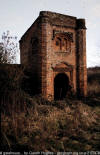|
Hidden East Anglia: Landscape Legends of Eastern England
|
||
|
|
Secret tunnel
A secret tunnel is said to run between the mainly
14th century church of St. Helen (TG356148) and the ruins of St. Benet's Abbey
(TG383157) less than
two miles across the river Bure. In it is said to be buried a vast amount of treasure belonging to the abbey, guarded by the phantom of a huge dog.
Sources:
1. J.
W. Day: 'Portrait of the Broads' (Robert Hale, 1967), p.47.
Lush's Bush
About halfway between Redenhall and Harleston a lane from Starston joins the main highway, forking as it meets the road. Both forks dip sharply down into the valley of a small stream that flows close by, and in the enclosed triangular piece here, covered with scrub and tall thorns, stood once a willow tree by the name of Lush's Bush (TM254843).
It was cut down at the end of the 19th century, but in the churchwarden's accounts for Redenhall is the entry, in 1668, "For planks and worke about Lush's bush and cutting of it...7s 6d". The tree, sometimes called Lush Bush, was said to have sprung from the wooden stake driven thru the heart of Lush, a murderer and suicide, who haunts the spot. More than one suicide was buried here though, the latest being recorded in the 'Norfolk Chronicle' of April 17th 1813.
Sources: Charles Candler: 'Notes on the Parish of Redenhall with Harleston' (Jarrold & Sons, 1896), pp.80-1. W. B. Gerish: 'Norfolk Folklore Collections' (unpublished, 1916-18, compiled by William de Castre), Vol.3, p.118.
Secret tunnel
Source: 'The East Anglian, or Notes & Queries', Vol.2 (Jan.1864-July 1866), p.202.
The Seven Hills
Sources: Alfred Suckling: 'History of Suffolk' (John Weale, 1846), Vol.1, p.xx11. Arthur Mee (ed.): 'The King's England - Norfolk' (Hodder & Stoughton, 1940), p.336.
According to tradition, the Danes were once laying siege to Thetford, but it became a stalemate. The defenders couldn't escape, and the Danes couldn't get past the fortifications of Castle Hill and Red Castle. Then a local shepherd named Tutt sold them out by showing them a passage through the westward marshes and a secret ford over the river. The Danes captured the town, then rewarded Tutt by hanging him on the mound that now bears his name, a Bronze Age bowl barrow at TL883813.
Source: W. G. Clarke: 'In Breckland Wilds' (Robert Scott, 1925), p.163.
Although not actually a tradition, I can't leave out the snippet that W. G. Clarke reported a hill figure in this area, possibly in the vicinity of the ridge called Great Snarehill. He said it was rumoured that "at one time there was near Thetford a 'white horse' which had been cut out of the short turf concealing the chalk". However, "all traces of its whereabouts are now lost".1 Now I've found a further mention of it as "a now vanished early C19th [Hanoverian] white horse at Thetford".2 There are also older references, from 1822 and 1884.3
Sources: 1. W. G. Clarke in 'The Eastern Counties Magazine & Suffolk Note-Book', Vol.1 & 2 (Aug.1900-May 1901), p.175. 2. 'Chalk East: A Geo-East Project' (Project Outline Document) 2009, p.6. 3. http://www.heritage.norfolk.gov.uk-Snarehill
Secret tunnel
As at Reedham above, St. Andrew's church (TF96202727) and the Boar (now the Blue Boar) Inn at Great Ryburgh are only separated by a road, but as is common, the two are once said to have been linked by a subterranean passage.
|
|

